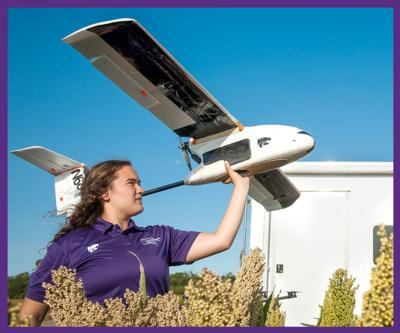New Waiver Also Permits The Remote Pilot In Command To Fly From A Mobile Command Center
The ability of Kansas State University Polytechnic Campus to fly unmanned aircraft systems beyond visual line of sight is expanding.

The campus's Applied Aviation Research Center has received a new waiver from the Federal Aviation Administration that permits K-State Polytechnic to fly unmanned aircraft beyond visual line of sight, or BVLOS, in all Class G airspace nationwide. Class G airspace is where a majority of UAS flights take place, allowing K-State Polytechnic and the Applied Aviation Research Center to enhance research, education and training opportunities.
Along with conducting flights in all Class G airspace, this new waiver also permits the remote pilot in command to fly from a mobile command center. Flying from a mobile command center allows for a controlled environment, meaning pilots can fly distraction-free, out of the elements, and monitor not only the live UAS feed but also weather, manned traffic, telemetry feed and more. This type of training situation will provide students with experience highly sought after in the UAS industry, as well as valuable training experience for professionals in public safety, emergency response, and more. This waiver will also allow K-State Polytechnic to continue research operations that move the industry forward.
"Kansas State Polytechnic's dedication toward its students is evident with the approval of this latest BVLOS waiver," said Spencer Schrader, UAS flight instructor at K-State Polytechnic and author of the waiver request submitted to the FAA. "Both for-credit and noncredit students will benefit from the advantages of this waiver, providing them experience with operations that are highly limited within the current regulatory framework of Part 107."

A nationally recognized leader in the UAS industry, K-State Polytechnic is a member of the Kansas UAS Joint Task Force and was the first university in the nation to receive a BVLOS waiver from the FAA in 2018, granting permission for K-State Polytechnic to fly beyond the visual line of sight of the pilot and visual observers in a single location. K-State Polytechnic is also a key partner with the Kansas Department of Transportation, which is one of the nine entities nationwide to be part of the FAA's UAS Integrated Pilot Program.
"We are committed to continually evolving our UAS program to ensure our students are prepared to enter the UAS industry with a broad range of relevant experience," said Kurt Carraway, UAS executive director of the Applied Aviation Research Center and department head of the program.
"This waiver allows us to train the way our industry partners want their pilots to operate. I am proud of our ability to conduct thorough operational risk assessments and articulate those into safety cases, such as this, to garner FAA approval for advanced UAS operations."
K-State Polytechnic and the Applied Aviation Research Center provide elite UAS education and training in the undergraduate and professional realm.
 ANN's Daily Aero-Linx (05.02.24)
ANN's Daily Aero-Linx (05.02.24) ANN's Daily Aero-Term (05.02.24): Touchdown Zone Lighting
ANN's Daily Aero-Term (05.02.24): Touchdown Zone Lighting Aero-News: Quote of the Day (05.02.24)
Aero-News: Quote of the Day (05.02.24) ANN FAQ: Contributing To Aero-TV
ANN FAQ: Contributing To Aero-TV NTSB Final Report: Cirrus Design Corp SR20
NTSB Final Report: Cirrus Design Corp SR20




